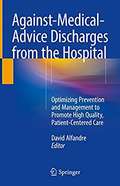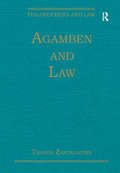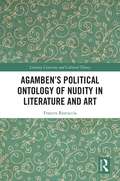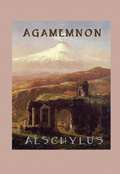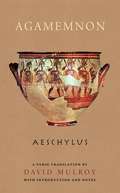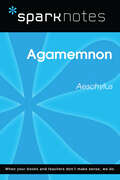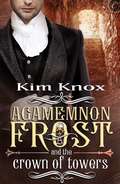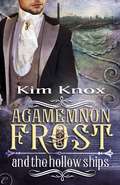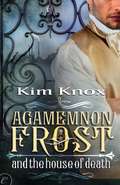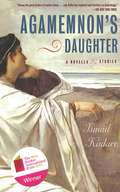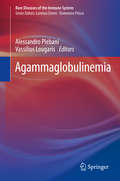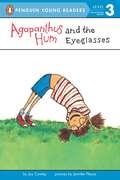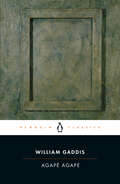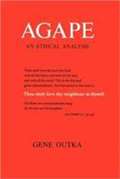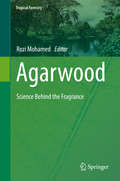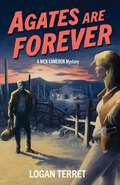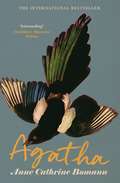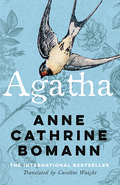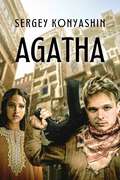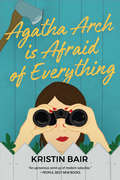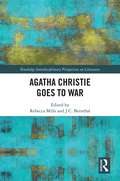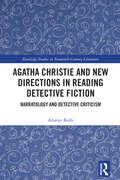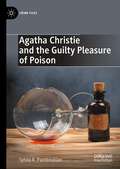- Table View
- List View
Against‐Medical‐Advice Discharges from the Hospital: Optimizing Prevention And Management To Promote High Quality, Patient-Centered Care
by David AlfandreFirst-of-its-kind text addressing the problem of against medical advice discharges in hospital-based healthcare.<P><P> Provides a comprehensive, multidisciplinary overview of a significant health care quality problem.<P> Addresses the legal, ethical, and institutional aspects of the problem as well as provides a framework for best practices for varied clinical disciplines including emergency medicine, pediatrics, psychiatry, hospital medicine, and nursing.<P>This first-of-its-kind text provides a multidisciplinary overview of a significant problem in hospital-based healthcare: patients who decline inpatient medical care and leave the hospital against medical advice (AMA). Compared to standard hospital discharges, AMA discharges are associated with worse health and health services outcomes. Patients discharged AMA have been found to have disproportionately higher rates of substance use, psychiatric illness, and report stigmatization and reduced access to care. By providing a far reaching examination of AMA discharges for a wide academic and clinical audience, the book serves as a reference for clinical care, research, and the development of professional guidelines and institutional policy. The book provides both a broad overview of AMA discharges with chapters on the epidemiology, ethical and legal aspects, as well as social science perspectives. For clinicians in the disciplines of hospital medicine, pediatrics, emergency medicine, nursing, and psychiatry, the book also provides a patient-centered analysis of the problem, case-based discussions, and a discussion of best practices. This comprehensive review of AMA discharges and health care quality will interest physicians and other health care professionals, social workers, hospital administrators, quality and risk managers, clinician-educators, and health services researchers.
Agamben and Law: Power, Law And The Uses Of Criticism (Philosophers And Law Ser.)
by Thanos ZartaloudisThis collection of articles brings together a selection of previously published work on Agamben‘s thought in relation to law and gathered from within the legal field and theory in particular. The volume offers an exemplary range of varied readings, reflections and approaches which are of interest to readers, students and researchers of Agamben‘s law-related work.
Agamben’s Political Ontology of Nudity in Literature and Art (Literary Criticism and Cultural Theory)
by Frances RestucciaThis volume develops the central (though neglected) Agambenian concept of nudity along with its crucial political implications. The book discovers within The Use of Bodies a philosophical path to Agamben’s "ontology of nudity," as it is subtended by his notion of the messianic—a dual temporality of form in motion reflected in the image of a whirlpool that is autonomous although no drop of water belongs to it separately. Drawn from Paul and Benjamin (rather than Derrida), Agamben’s messianic is elaborated in this study through its embodiment in literature—Woolf’s To the Lighthouse, James’s The Aspern Papers, Brodsky’s Watermark, and Mann’s Death in Venice—in response to Agamben’s insistence on the wedding of poetry and philosophy. In particular, Coetzee’s Disgrace gives poetic form to Agamben’s focus on the dissolution of the human/animal border, the salvation of the unsavable, and "nudity"—all to illustrate Agamben’s Open without a closedness. This text shows how art serves as the house of philosophy also by taking up the nude in visual art, making the case that, in comprising chronos and kairos (the two messianic components of Agamben’s ontology of nudity), art demonstrates the constitution of form-of-life for the viewer. Emphasizing Agamben’s privileged non-unveilability/nudity, this book finally examines two major missed encounters, with Heidegger and Lacan, philosophers of the veil. Veiling to Agamben correlates with the sovereignty/bare life structure of the exception, which his ontology of nudity is meant to deactivate—as there is no such thing as a bare life.
Agamemnon
by AeschylusAeschylus' Agamemnon, first produced in 458 BC, is the opening play in his Oresteian trilogy. Agamemnon returns home after the Trojan Wars with his concubine Cassandra and is murdered by his wife Clytemnestra and her lover, Aegisthus. The ensuing blood feud continues until the third and final play, Eumenides, when peace is finally restored to the house of the Atreidae. It is a powerful and moving play which is difficult to interpret and which for a long time lacked an English edition.
Agamemnon
by Aeschylus David MulroyAgamemnon, King of Argos, returns to Greece a victor in the Trojan War. He has brought with him the seer Cassandra as his war-prize and concubine. Awaiting him is his vengeful wife Clytemnestra, who is angry at Agamemnon's sacrifice of their daughter Iphigeneia to the gods, jealous of Cassandra, and guilty of taking a lover herself. The events that unfold catch everyone in a bloody net, including their absent son Orestes. Aeschylus (525-456 BC) was the first of the three great tragic dramatists of ancient Greece, a forerunner of Sophocles and Euripides. His early tragedies were largely choral pageants with minimal plots. In Agamemnon, choral songs still predominate, but Aeschylus infuses them with such dramatic feeling that the spectator or reader is constantly spellbound. Translator David Mulroy brings this ancient tragedy to life for modern readers and audiences. Using end rhyme and strict metrics, he combines the buoyant lyricism of the Greek text with a faithful rendering of its meaning in lucid English.
Agamemnon (SparkNotes Literature Guide Series)
by SparkNotesAgamemnon (SparkNotes Literature Guide) by Aeschylus Making the reading experience fun!Created by Harvard students for students everywhere, SparkNotes is a new breed of study guide: smarter, better, faster.Geared to what today's students need to know, SparkNotes provides:chapter-by-chapter analysisexplanations of key themes, motifs, and symbolsa review quiz and essay topicsLively and accessible, these guides are perfect for late-night studying and writing papers.
Agamemnon Frost and the Crown of Towers
by Kim KnoxBook three of Agamemnon FrostEdgar Mason is losing Agamemnon Frost despite everything they've been through-the passion, the torture, the heat. Frost's fiancée, Theodora, is back, and Mason can feel his lover gravitating toward her. Every day he sees them together, it tears at his heart.Frost feels raw himself. His brother and sister-in-law are missing, and his guilt about failing to save Theodora from Pandarus eats at him. His feelings for Mason, whom he has put through hell twice already, just twist the screws tighter.On top of that, Pandarus and the Martians are back to make their final push to Earth, and Frost and Mason are duty bound to fight them. People are vanishing. Bodies are turning up burned beyond recognition in the slums. The bleak, human-less future Frost and Mason saw in the hollow ships has nearly come to pass.And in order to prevent it, each man will have to make a final choice: lose his lover or doom the world.Find out how it began in Agamemnon Frost and the House of Death.32,000 words
Agamemnon Frost and the Hollow Ships
by Kim KnoxBook two of Agamemnon FrostEdgar Mason is ready to embark upon his new life at Agamemnon Frost's side. But all is not perfect. His Martian overlord, Pandarus, has implanted a dark voice in his mind, a voice that urges betrayal. And though Mason can keep close to Frost, there's little room for romance under the watchful gaze of the engineers from Station X.That changes when Mason and Frost reopen their investigation into their old enemy's whereabouts. Posing as double agents and investigating cryptic rumors of "hollow ships," they find him impersonating a London banker and worm their way into his confidence.But their success brings them trouble in spades. Pandarus takes them into the belly of his ships, where he plans to transfigure them into mindless automata. And with Earth on the brink of invasion, Frost's old flame Theodora reappearing and Pandarus's brainwashing growing more effective, Mason and Frost will find their bond tested as never before.See how it all began in Agamemnon Frost and the House of Death. 28,000 words
Agamemnon Frost and the House of Death
by Kim KnoxBook one of Agamemnon FrostLiverpool, 1891Decorated artilleryman Edgar Mason was forced to find new work when the British Empire replaced its foot soldiers with monstrous machines. Now he waits on the Liverpool elite as a personal servant. He has just one rule: he won't work for fashion-addled dandies.Agamemnon Frost, however, is far from the foppish man-about-town he appears to be. He's working to protect the Earth from an alien invasion being planned by a face-changing creature known as Pandarus. And on the night he plans to confront the aliens, he enlists Mason to assist him.For a man to love a man is a serious crime in Victorian England. But when Mason meets Frost, his heart thunders and his blood catches fire. And when Pandarus drags the two men into the torture cellars beneath his house of death to brainwash them, Mason's new passion may be all that stands between him and insanity.The trilogy continues with Agamemnon Frost and the Hollow Ships.26,000 words
Agamemnon's Daughter: A Novella & Stories
by Ismail Kadare David BellosPsychologically incisive and impeccably crafted, Agamemnon's Daughter tells the crushing story of passion shattered by a heartless regime. Once again, Kadare denounces with rare force the machinery of oppression, drawing us back to the ancient roots of Western civilization and tyranny.This collection also showcases two masterful stories: "The Blinding Order," a parable about the uses of terror in the Ottoman Empire, and "The Great Wall," a chilling duet between a Chinese official and a soldier in the invading army of the great conqueror, Tamerlane.
Agammaglobulinemia (Rare Diseases of the Immune System #4)
by Alessandro Plebani Vassilios LougarisThis book provides an updated overview of agammaglobulinemia, a rare form of primary immunodeficiency which is considered the prototype of the congenital humoral defects, and which is characterized by the absence of peripheral B cells and very low serum immunoglobulin levels. The book opens by discussing the highly orchestrated early B cell development in the bone marrow and the genes involved based on both human and animal models. The pathogenesis and clinical presentation of X-linked agammaglobulinemia, caused by mutations in the BTK (Bruton's tyrosine kinase) gene, are then presented in detail, followed by descriptions of the clinical manifestations and molecular basis of the less frequent autosomal recessive and autosomal dominant forms of agammaglobulinemia. Patients' management in terms of respiratory complications, gammaglobulin replacement therapy and the potential value of novel experimental therapeutic strategies are discussed. The book's closing chapters offer a comprehensive and updated description of mutations in the BTK gene, and the expression and function of BTK in cells other than B cells.
Agapanthus Hum and the Eyeglasses (Penguin Young Readers, Level 3)
by Joy CowleyAgapanthus Hum is a whirlwind. She hums, she cartwheels, and she is always running around. Now that Agapanthus has eyeglasses, her parents want her to be careful. Agapanthus tries to slow down; she even wears a bag on her head so her glasses won't get lost, but more often then not, her glasses go flying. What do grown-up acrobats do with their eyeglasses? Agapanthus's parents bring her to a performance so that she can find out.
Agape Agape
by William GaddisThe late William Gaddis wrote four novels during his lifetime, immense and complex books that helped inaugurate a new movement in American letters. Now comes his final work of fiction, a subtle, concentrated culmination of his art and ideas. For more than fifty years Gaddis collected notes for a book about the mechanization of the arts, told via a social history of the player piano in America. In the years before his death in 1998, he distilled the whole mass into a fiction, a dramatic monologue by an elderly man with a terminal illness. This "man in the bed" lies dying, thinking anxiously about the book he still plans to write, grumbling about the deterioration of civilization and trying to explain his obsession to the world before he passes away or goes mad. Agape- Agapecontinues Gaddis's career-long reflection via the form of the novel on those aspects of the corporate technological culture that are uniquely destructive of the arts. It is a stunning achievement from one of the indisputable masters of postwar American fiction.
Agape: An Ethical Analysis
by Gene OutkaA professor of religion considers the various ethical problems raised by the idea of unconditional love.
Agarwood: Science Behind the Fragrance (Tropical Forestry)
by Rozi MohamedThis book gives readers new information to understand the mechanism of agarwood induction and therefore eradicate the myths surrounding agarwood formation. One of the challenges in conserving agarwood resources is species identification. In this book, taxonomy and systematics of agarwood-producing trees from historical and recent perspectives is discussed, and tips are given for identifying cultivated species. In addition, color illustrations are given to highlight vegetative and reproductive characteristics as well as anatomical features, for identification purposes of both plant and agarwood sources. Another challenge that planters are facing is in acquiring the correct method for agarwood induction, thus development of agarwood induction technologies will be reviewed. A chapter dedicated to bioinduction is included. The book will comprise a chapter on the use of non-destructive technology as a management tool for cultivating agarwood. The book also discusses issues relating to agarwood grades. The absence of an international standard that is acceptable by producer and consumer countries further complicates the issue. Other useful information includes a systematic revelation of agarwood constituents and their complex chemistry, and highlights on a specific pharmaceutical property.
Agates Are Forever: A Nick Cameron Mystery
by Logan TerretFor fans of Western mystery novels like C. J. Box&’s Joe Pickett series and Craig Johnson&’s Walt Longmire Mysteries comes a witty, thrilling mystery fueled by diverse characters and set against the stunning backdrop of the Arizona desert.Nick Cameron is a PhD geologist of independent means who boxes for fun, packs a Colt Commander, and has a knack for finding bodies—dead and alive. When an agate heiress arrives in Quartzrock, Arizona, on the eve of a gem show, she asks Nick for help selling some gemstones—and soon becomes a suspect in the bizarre murders of two prominent lapidaries. Stalked by the mysterious killer, she and Nick dodge police while Nick works with his friend Frankie Benally—a Navajo jewelry artist and brilliant armchair detective—to unravel the case. But even Frankie is stumped—until, at an isolated hacienda deep in the Sonoran desert, Nick meets the great-granddaughter of a soldadera who served with Pancho Villa&’s División del Norte.Along the way, Nick gets help from an old-fashioned gentleman sheriff, a crusty army retiree, and a clutch of feisty dames. He navigates plot twists and red herrings that would make Sam Spade reach for the aspirin. And he does it all with deadpan humor that&’ll make you spit up your bourbon.
Agatha
by Anne Cathrine BomannA psychiatrist is counting down towards his upcoming retirement. He lives alone in his childhood home and has neither friends nor family.Often, he resorts to drawing bird caricatures of his patients instead of taking notes. His social life consists of brief conversations with his meticulous secretary Madame Surrugue, who has reigned over the clinic for more than thirty years. The two of them have no relationship outside the office, where everything runs smoothly and uneventfully.Until one day, that is, when a young German woman called Agatha arrives and demands to see the doctor and he soon realizes that underneath her fragile exterior is a strong and fascinating woman. The doctor and Agatha embark upon a course of therapy together, a process that forces the doctor to confront his fear of true intimacy outside the clinic. But is it too late to reconsider your existence as a 71-year-old?
Agatha
by Caroline Waight Anne Cathrine BomannTHE INTERNATIONAL BESTSELLERA psychiatrist is counting down towards his upcoming retirement. He lives alone in his childhood home and has neither friends nor family.Often, he resorts to drawing bird caricatures of his patients instead of taking notes. His social life consists of brief conversations with his meticulous secretary Madame Surrugue, who has reigned over the clinic for more than thirty years. The two of them have no relationship outside the office, where everything runs smoothly and uneventfully.Until one day, that is, when a young German woman called Agatha arrives and demands to see the doctor and he soon realizes that underneath her fragile exterior is a strong and fascinating woman. The doctor and Agatha embark upon a course of therapy together, a process that forces the doctor to confront his fear of true intimacy outside the clinic. But is it too late to reconsider your existence as a 71-year-old?
Agatha
by Anne Cathrine BowmanTHE INTERNATIONAL BESTSELLERA psychiatrist is counting down towards his upcoming retirement. He lives alone in his childhood home and has neither friends nor family.Often, he resorts to drawing bird caricatures of his patients instead of taking notes. His social life consists of brief conversations with his meticulous secretary Madame Surrugue, who has reigned over the clinic for more than thirty years. The two of them have no relationship outside the office, where everything runs smoothly and uneventfully.Until one day, that is, when a young German woman called Agatha arrives and demands to see the doctor and he soon realizes that underneath her fragile exterior is a strong and fascinating woman. The doctor and Agatha embark upon a course of therapy together, a process that forces the doctor to confront his fear of true intimacy outside the clinic. But is it too late to reconsider your existence as a 71-year-old?Praise for Agatha:"Charming, funny and packed with insight." —Irish Times"This short, uplifting book brings us a more fully-realised character than most authors could manage with three times the room, and some painfully hard-won moments of genuine human contact in an arid life." —The National
Agatha
by Sergey Konyashin2010. After graduating from university in Moscow, a native of Argentina, Agata Garcia Lopez, should return to her homeland. Before leaving home, she decides to visit Yemen, where her good university friend Andrey Zorin serves at the Russian embassy. However, a few days after her arrival in the Yemeni capital, a war begins in the strife-torn country. To return to Moscow, the girl will have to take part in an operation to evacuate Russian citizens. And at the same time to sort out her feelings for the friend who invited her… The story is an artistic, not a documentary-historical work. All her characters and the events described are completely fictional. The book may be of interest to fans of adventure prose and fiction about the Arab Middle East. Translated from Russian.
Agatha Arch is Afraid of Everything: A Novel
by Kristin BairA quirky, nervous wreck of a New England mom is forced to face her many fears in this touching, irresistible novel from author Kristin Bair.Agatha Arch's life shatters when she discovers her husband in their backyard shed, in flagrante delicto, giving the local dog walker some heavy petting. Suddenly, Agatha finds herself face to face with everything that frightens her...and that's a loooooong list.Agatha keeps those she loves close. Everyone else, she keeps as far away as possible. So she's a mystery to nearly everyone in her New England town. To her husband, she's a saucy, no-B.S. writer. To her Facebook Moms group, she's a provocateur. To her neighbor, she's a standoffish pain in the butt. To her sons, she's chocolate pudding with marshmallows. And to her shrink, she's a bundle of nerves on the brink of a cataclysmic implosion.Defying her abundant assortment of anxieties, Agatha dons her "spy pants"--a pair of khakis whose many pockets she crams with binoculars, fishing line, scissors, flashlight, a Leatherman Super Tool 300 EOD, candy, and other espionage essentials--and sets out to spy on her husband and the dog walker. Along the way, she finds another intriguing target to follow: a mysterious young woman who's panhandling on the busiest street in town.It's all a bit much for timorous Agatha. But with the help of her Bear Grylls bobblehead, a trio of goats, and a dog named Balderdash, Agatha may just find the courage to build a better life."Fans of Where'd You Go, Bernadette and Elinor Oliphant Is Completely Fine will love this clever romp."--Publishers Weekly, starred review
Agatha Christie Goes to War (Routledge Interdisciplinary Perspectives on Literature)
by J. C. Bernthal Rebecca MillsAgatha Christie has never been substantially considered as a war writer, even though war is a constant presence in her writing. This interdisciplinary collection of essays considers the effects of these conflicts on the social and psychological textures of Christie’s detective fiction and other writings, demonstrating not only Christie’s textual navigation of her contemporary surroundings and politics, but also the value of her voice as a popular fiction writer reflecting popular concerns. Agatha Christie Goes to War introduces the ‘Queen of Crime’ as an essential voice in the discussion of war, warfare, and twentieth century literature.
Agatha Christie Trivia
by Richard T. RyanHundreds of questions about Agatha Christie's mysteries - the crimes, the criminals, the clues, the detectives, supporting players, and much more
Agatha Christie and New Directions in Reading Detective Fiction: Narratology and Detective Criticism (Routledge Studies in Twentieth-Century Literature)
by Alistair RollsThis book brings a new lens to the work of Agatha Christie through a series of close readings which challenge the official solutions by Hercule Poirot and Miss Marple. This book's approach interweaves two core ideas: first, it explores the importance of French critic Pierre Bayard’s self-styled ‘detective criticism’; second, it takes detective criticism in a new direction by refocusing on the beginnings of Agatha Christie’s novels. In this way, the book counters the end-orientation that has traditionally dominated the reading experience of, and critical response to, detective fiction by exploring the potential of the beginning to host other interpretations and stories. Offering a new way of reading detective fiction, this book is a mixture of narratology and detective criticism, and deploys it in the form of radical new readings of a number of Christie’s most famous works. This illuminating text will interest students and scholars of crime and detective fiction, literary studies, and comparative literature.
Agatha Christie and the Guilty Pleasure of Poison (Crime Files)
by Sylvia A. PamboukianAgatha Christie and the Guilty Pleasure of Poison examines Christie’s female poisoners in the context of Christie’s own experience in pharmacy and of detective fiction. In doing so, it uncovers an overlooked dynamic in which female poisoners deliver well-deserved comeuppance for gendered and classed wrongdoing ordinarily accepted in everyday life. While critics have long recognized male outlaws, like Robin Hood, who use crime to oppose a corrupt system, this book contends that female outlaws – witches and poisoners – offer a similar heritage of empowered femininity. Far from cozy and formulaic, Agatha Christie’s outlaw poisoners offer readers the surprising pleasures of comeuppance, and they set the stage for contemporary detective fiction writers, more recent films depicting poisoning as empowering, and even poison gardens, which are tourist destinations that offer visitors the guilty pleasure of poison.
